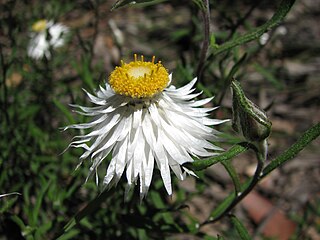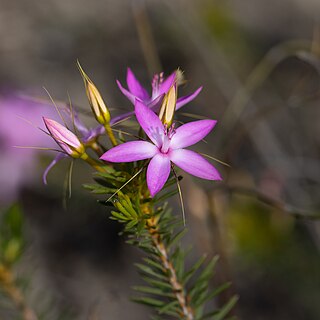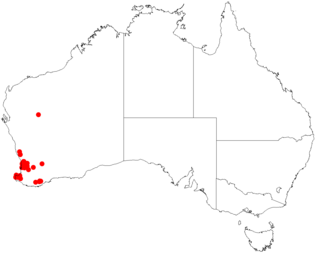
Lechenaultia linarioides, commonly named yellow leschenaultia, is a species of flowering plant in the family Goodeniaceae and is endemic to near-coastal areas in the west of Western Australia. It is a sprawling subshrub with many tangled branches, narrow, crowded, rather fleshy leaves, and yellow and deep pink to purplish red flowers.

Brachyscome multifida is a perennial herb in the family Asteraceae. Common names include cut-leaved daisy, rocky daisy, and Hawkesbury daisy. The species is endemic to Australia.

Actinotus minor, commonly known as the lesser flannel flower, is species of flowering plant in the family Apiaceae and is endemic to New South Wales. It is a small, sprawling plant with grey-green leaves and white flowers.

Helichrysum leucopsideum, commonly known as satin everlasting, is a flowering, perennial herb in the family Asteraceae. It is grows in all states of Australia except Queensland and the Northern Territory. It has white, terminal flower heads and narrow, woolly leaves.
Persoonia hakeiformis is a species of flowering plant in the family Proteaceae and is endemic to the south-west of Western Australia. It is an erect or spreading to low-lying shrub with mostly smooth bark, linear leaves and bright yellow flowers borne in groups of up to sixty along a rachis up to 100 mm (3.9 in) long.

Calytrix decandra, commonly known as pink starflower, is a species of flowering plant in the myrtle family Myrtaceae and is endemic to the south of Western Australia. It is a semi-prostrate, glabrous shrub with linear to narrowly elliptic leaves and pink, mauve or magenta flowers with usually 10 stamens in a single row.

Conospermum crassinervium, commonly known as summer smokebush or tassel smokebush, is a species of flowering plant in the family Proteaceae, and is endemic to the south-west of Western Australia. It is a low, tufted shrub with clustered leaves arranged at the base of the plant and corymbs of spikes of white to grey, hairy, tube-shaped flowers.

Petrophile carduacea is a species of flowering plant in the family Proteaceae and is endemic to the south-west of Western Australia. It is a shrub with deeply toothed leaves, and more or less spherical heads of hairy yellow flowers.

Marianthus tenuis is a species of flowering plant in the family Pittosporaceae and is endemic to the southwest of Western Australia. It is a slender, twining shrub with clustered, narrowly elliptic leaves and white flowers tinged with mauve and with darker spots on three of the five petals.

Tremandra stelligera is a flowering plant in the family Elaeocarpaceae. It is a small upright shrub with pink, purple or blue flowers, dark green oval shaped leaves and is endemic to Western Australia.

Podolepis canescens is a herb in the Asteraceae family, which is found in South Australia, the Northern Territory, New South Wales and Victoria. PlantNet also states that it is found in Western Australia, but FloraBase states that the name is misapplied in Western Australia, based on Jeanes (2015).
Teucrium sessiliflorum, commonly known as camel bush, is a species of flowering plant in the family Lamiaceae and is endemic to southern continental Australia. It is a tufted perennial herb with hairy, egg-shaped, lobed leaves and white or cream-coloured flowers.

Podolobium scandens, commonly known as netted shaggy-pea, is a flowering plant in the family Fabaceae and is endemic to eastern Australia. It is a prostrate, small shrub with orange-yellow pea-like flowers and red markings.

Chrysocephalum baxteri, known by the common name fringed everlasting is a perennial herb native to southern Australia. It is a member of the Asteraceae, the daisy family. Found in low heath country and sclerophyll forest. A small plant, 10 to 40 cm high with many stems. Leaves are linear in shape, 4 to 30 mm long, 0.5 to 2.5 mm wide. Both leaf surfaces are a felty grey/green. White flowers mostly form in spring and summer.
Olearia elaeophila is a species of flowering plant in the family Asteraceae and is endemic to the south-west of Western Australia. It is a small shrub with scattered linear leaves, and white or blue and yellow, daisy-like inflorescences.
Olearia hygrophila, commonly known as swamp daisy or water daisy, is a species of flowering plant in the family Asteraceae and is endemic to a restricted part of North Stradbroke Island in south-eastern Queensland. It is a shrub with slender stems, linear leaves and white and yellow, daisy-like inflorescences.

Olearia ramosissima, commonly known as much-branched daisy bush, is a species of flowering plant in the family Asteraceae and is endemic to continental Australia. It is a straggly shrub with densely-crowded, elliptic, egg-shaped or triangular leaves, and blue to violet and blue or yellow, daisy-like inflorescences.

Minuria leptophylla commonly known as minnie daisy, is a flowering plant in the family Asteraceae. It is a small perennial herb with white daisy-like flowers. It is endemic to Australia and grows in all mainland states.

Leucopogon tenuis is a species of flowering plant in the heath family Ericaceae and is endemic to the southwest of Western Australia. It is an erect shrub with slender, wand-like branches, linear or narrowly lance-shaped leaves and white, tube-shaped flowers arranged in cylindrical spikes on the ends of branches.

Melichrus adpressus, commonly known as large nectar-heath, is a flowering plant in the family Ericaceae. It is an upright small shrub with whitish-green flowers.
















